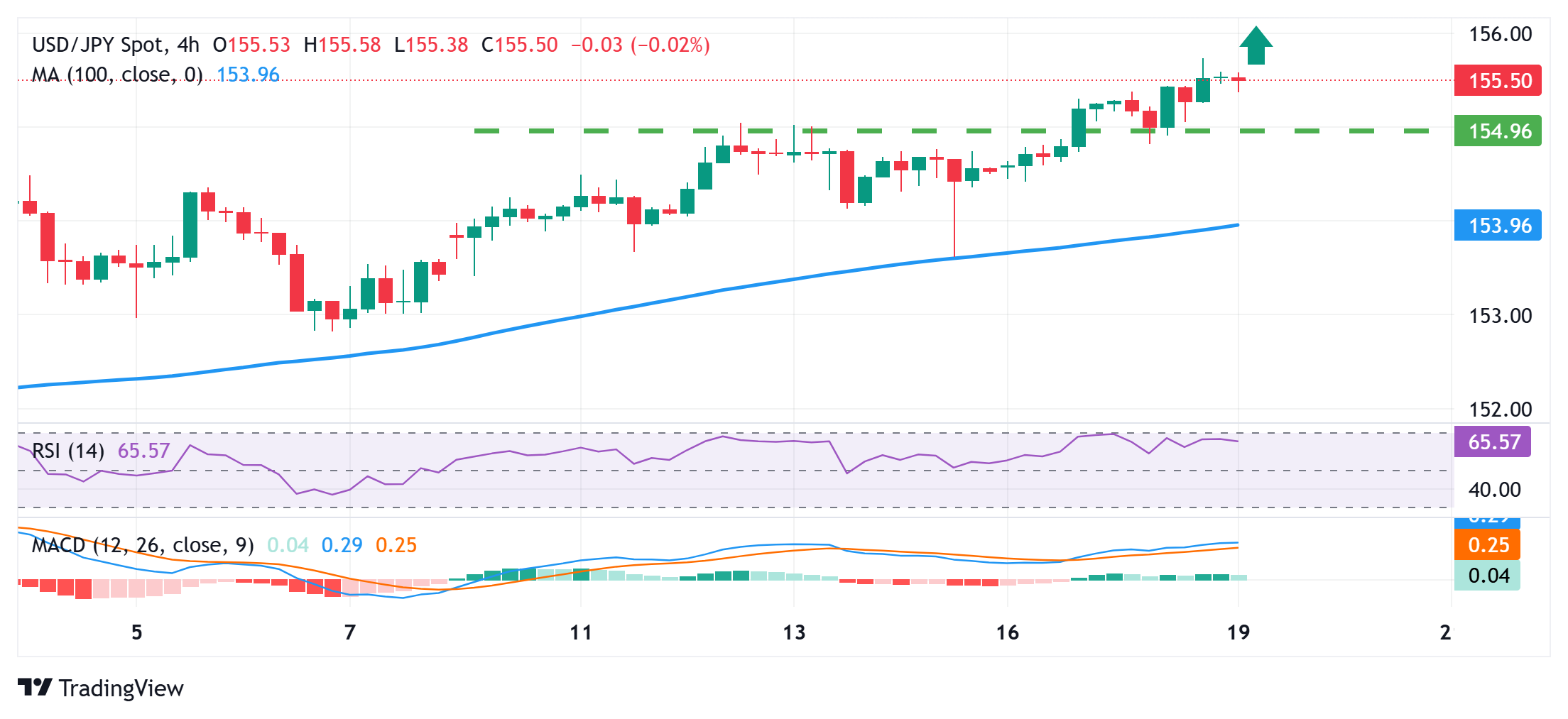Japanese Yen hangs near multi-month low against USD amid fiscal concerns, BoJ uncertainty
- The Japanese Yen continues to be undermined by fiscal concerns, BoJ uncertainty.
- Intervention fears and the risk-off mood offer some support to the safe-haven JPY.
- A softer USD contributes to capping USD/JPY ahead of the FOMC meeting minutes.
The Japanese Yen (JPY) oscillates in a range during the Asian session on Wednesday and remains close to its lowest level since late February, touched against the US Dollar (USD) the previous day. Investors remain uncertain about the Bank of Japan's (BoJ) policy tightening path amid Japan's Prime Minister Sanae Takaichi's expansionary fiscal policy stance and her preference for interest rates to stay low. This has been as a key factor behind the JPY's relative underperformance recently and backs the case for a further near-term depreciating move.
However, a growing risk that authorities would step into the market to stem further JPY weakness is holding back bears from placing aggressive bets. Moreover, a generally weaker tone around the equity markets turns out to be another factor that helps limit the downside for the safe-haven JPY. The USD, on the other hand, struggles to attract any meaningful buyers amid worries about the weakening economic momentum on the back of the longest-ever US government shutdown. This contributes to capping the upside for the USD/JPY pair.
Japanese Yen bears retain control as Takaichi's policies could delay BoJ rate hike
- A panel, consisting of lawmakers from Japan's ruling Liberal Democratic Party, proposed on Tuesday compiling a supplementary budget exceeding ¥25 trillion to fund Prime Minister Sanae Takaichi's planned stimulus package. This fuels anxiety over the supply of new government debt and pushes the yield on the 40-year Japanese government bonds to a record high.
- Takaichi said last week that Japan still faced the risk of returning to deflation and added that she strongly hopes the Bank of Japan achieves inflation driven by wages rather than primarily through rising food costs. Takaichi urged the BoJ to cooperate with government efforts to reflate the economy and also voiced her displeasure over the idea of raising interest rates.
- Meanwhile, speculations that the recent decline in the Japanese Yen could trigger intervention from government authorities hold back bearish traders from placing fresh bets. Adding to this, the prevalent risk-off environment offers some support to safe-haven JPY, which, along with the lack of US Dollar buying, keeps a lid on further gains for the USD/JPY pair.
- The USD bulls await the release of delayed US macro data for clues about the health of the world's largest economy amid signs of a softening labor market and the Federal Reserve's next move. In fact, Fed Vice Chair Philip Jefferson said the central bank needs to proceed slowly, while Fed Governor Christopher Waller continued to build the case for further rate cuts.
- Hence, the market focus will remain glued to the release of FOMC meeting Minutes, due later this Wednesday, which will play a key role in influencing the near-term USD price dynamics. The attention will then shift to the closely-watched US Nonfarm Payrolls report for September on Thursday. The latter should provide some meaningful impetus to the USD/JPY pair.
USD/JPY seems poised to climb further towards reclaiming the 156.00 mark

This week's back-to-back close above the 155.00 psychological mark and positive oscillators suggest that the path of least resistance for the USD/JPY pair remains to the upside. Hence, some follow-through strength, towards reclaiming the 156.00 round figure, looks like a distinct possibility. The momentum could extend further towards the next relevant hurdle near the 156.50-156.60 region, above which spot prices to climb to the 157.00 mark en route to the 157.35 area.
On the flip side, corrective pullbacks might now find decent support near the 155.00 mark, and any further weakness is more likely to attract fresh buyers near the 154.50-154.45 horizontal resistance breakpoint. The latter should act as a key pivotal point, below which the USD/JPY pair could extend the fall towards the 154.00 round figure en route to the next relevant support near the 153.60-153.50 region and the 153.00 mark.
Japanese Yen FAQs
The Japanese Yen (JPY) is one of the world’s most traded currencies. Its value is broadly determined by the performance of the Japanese economy, but more specifically by the Bank of Japan’s policy, the differential between Japanese and US bond yields, or risk sentiment among traders, among other factors.
One of the Bank of Japan’s mandates is currency control, so its moves are key for the Yen. The BoJ has directly intervened in currency markets sometimes, generally to lower the value of the Yen, although it refrains from doing it often due to political concerns of its main trading partners. The BoJ ultra-loose monetary policy between 2013 and 2024 caused the Yen to depreciate against its main currency peers due to an increasing policy divergence between the Bank of Japan and other main central banks. More recently, the gradually unwinding of this ultra-loose policy has given some support to the Yen.
Over the last decade, the BoJ’s stance of sticking to ultra-loose monetary policy has led to a widening policy divergence with other central banks, particularly with the US Federal Reserve. This supported a widening of the differential between the 10-year US and Japanese bonds, which favored the US Dollar against the Japanese Yen. The BoJ decision in 2024 to gradually abandon the ultra-loose policy, coupled with interest-rate cuts in other major central banks, is narrowing this differential.
The Japanese Yen is often seen as a safe-haven investment. This means that in times of market stress, investors are more likely to put their money in the Japanese currency due to its supposed reliability and stability. Turbulent times are likely to strengthen the Yen’s value against other currencies seen as more risky to invest in.
